
Why are fossil fuels so hard to quit?
We understand today that humanity’s use of fossil fuels is severely damaging our environment. Fossil fuels cause local pollution where they are produced and used, and their ongoing use is causing lasting harm to the climate of our entire planet. Nonetheless, meaningfully changing our ways has been very difficult.
But suddenly, the COVID-19 pandemic brought trade, travel, and consumer spending to a near-standstill. With billions of people recently under stay-at-home orders and economic activity plunging worldwide, the demand for and price of oil have fallen further and faster than ever before. Needless to say, oil markets have been in turmoil and producers around the world are suffering.

Some pundits are now asking if this crisis could be the push the world needs to move away from oil. One asked: “Could the coronavirus crisis be the beginning of the end for the oil industry?” Another: “Will the coronavirus kill the oil industry and help save the climate?” Meanwhile, 2020 annual greenhouse gas emissions are forecast to decline between 4 – 7% as a result of the virus’ effects, and some of the world’s smoggiest cities are currently enjoying clear skies.
The idea that the pandemic could ultimately help save the planet misses crucial points. First and foremost, damaging the world’s economy is not the way to deal with climate change. And in terms of oil, what will take its place? We haven’t found a good substitute for oil, in terms of its availability and fitness for purpose. Although the supply is finite, oil is plentiful and the technology to extract it continues to improve, making it ever-more economic to produce and use. The same is also largely true for natural gas.
Climate change is real and we see its effects clearly now: In 2019 worldwide, 15 extreme weather events, exacerbated by climate change, caused more than $1 billion in damage each. Four of these events each caused more than $10 billion in damage. The large-scale use of fossil fuels tops the list of factors contributing to climate change. But the concentrated energy that they provide has proven hard to replace. Why?
A reporter raised that very question to me after a press Q&A that I did at a conference a few years ago. “We know that oil contributes to climate change and other environmental problems — why do we still use it? Why don’t we just quit already?,” he asked me.
Until that moment, I hadn’t thought enough about how my experience and background give me a clearer view than many on the promise and challenge of moving to a cleaner energy system. I have gained a wide-angle view of the energy industry as I’ve moved through my career, working in government and in consulting — for both oil and gas and clean energy clients — and then moving into the think tank world.
fossil fuel
Generated from the decomposition of ancient plant and animal matter over millions of years. Coal, oil, and natural gas are fossil fuels.
To deal with the challenge of climate change, we must start by understanding the fossil fuel system — namely how energy is produced and used. Although fossil fuel companies are politically powerful, in the United States and around the world, their lobbying prowess is not the key reason that their fuels dominate the global energy system. Likewise, the transition to an all-renewable energy system is not a simple task. But the politics of blame are popular, as we’ve seen during the 2020 election campaign and in light of recent lawsuits against fossil fuel companies. There is plenty of blame to go around, from fossil fuel companies that for years denied the problem to policymakers reluctant to enact the policies needed to force real change. It has been easier for everyone to stick with the status quo.
The world needs technology and strong policy to move in a new direction. Throughout history, humanity’s energy use has moved toward more concentrated, convenient, and flexible forms of energy. Understanding the advantages of today’s energy sources and the history of past transitions can help us understand how to move toward low-carbon energy sources. With greater understanding of the climate challenge, we are making huge strides in developing the technology we need to move toward a low-carbon future. Still, understanding how we got here and why the modern world was built on fossil fuels is crucial to understanding where we go from here.
Our energy comes from the sun, one way or another
In the pre-industrial age, solar energy met all of humanity’s energy needs. Plants convert solar energy into biomass through the process of photosynthesis. People burned this biomass for heat and light. Plants provided food for people and animals, which, in turn, used their muscle power to do work. Even as humans learned to smelt metals and make glass, they fueled the process with charcoal made from wood. Apart from photosynthesis, humans made some use of wind and water power, also ultimately fueled by the sun. Temperature differences in the atmosphere brought about by sunlight drive the wind, and the cycle of rainfall and flowing water also gets its energy from sunlight. But the sun is at the center of this system, and people could only use the energy that the sun provided in real time, mostly from plants.
biomass
Plant material, including leaves, stalks, and woody mass. Biomass can be burned directly or processed to create biofuels, like ethanol.
This balance between human energy use and sunlight sounds like utopia, but as the human population grew and became more urban, the bio-based energy system brought problems. In England, wood became scarce in the 1500s and 1600s, since it was not only used for fuel, but also for building material. London, for instance, grew from 60,000 people in 1534 to 530,000 in 1696, and the price of firewood and lumber rose faster than any other commodity. The once lush forests of England were denuded.
In 1900, roughly 50,000 horses pulled cabs and buses around the streets of London, not including carts to transport goods. As you can imagine, this created an enormous amount of waste. As Lee Jackson writes in his book “Dirty Old London,” by the 1890s London’s immense horse population generated roughly 1,000 tons of dung per day. All this manure also attracted flies, which spread disease. The transportation system was literally making people sick. The pre-fossil era was not the utopia we envision.
Fossil fuels opened new doors for humanity. They formed from the transformation of ancient plants through pressure, temperature, and tens to hundreds of millions of years, essentially storing the sun’s energy over time. The resulting fuels freed humanity from its reliance on photosynthesis and current biomass production as its primary energy source. Instead, fossil fuels allowed the use of more energy than today’s photosynthesis could provide, since they represent a stored form of solar energy.
First coal, then oil and natural gas allowed rapid growth in industrial processes, agriculture, and transportation. The world today is unrecognizable from that of the early 19th century, before fossil fuels came into wide use. Human health and welfare have improved markedly, and the global population has increased from 1 billion in 1800 to almost 8 billion today. The fossil fuel energy system is the lifeblood of the modern economy. Fossil fuels powered the industrial revolution, pulled millions out of poverty, and shaped the modern world.
How energy density and convenience drove fossil fuel growth
The first big energy transition was from wood and charcoal to coal, beginning in the iron industry in the early 1700s. By 1900, coal was the primary industrial fuel, taking over from biomass to make up half the world’s fuel use. Coal has three times the energy density by weight of dry wood and is widely distributed throughout the world. Coal became the preferred fuel for ships and locomotives, allowing them to dedicate less space to fuel storage.
Oil was the next major energy source to emerge. Americans date the beginning of the oil era to the first commercial U.S. oil well in Pennsylvania in 1859, but oil was used and sold in modern-day Azerbaijan and other areas centuries earlier. Oil entered the market as a replacement for whale oil for lighting, with gasoline produced as a by-product of kerosene production. However, oil found its true calling in the transportation sector. The oil era really took off with the introduction of the Ford Model-T in 1908 and the boom in personal transportation after World War II. Oil overtook coal to become the world’s largest energy source in 1964.
Oil resources are not as extensively distributed worldwide as coal, but oil has crucial advantages. Fuels produced from oil are nearly ideal for transportation. They are energy-dense, averaging twice the energy content of coal, by weight. But more importantly, they are liquid rather than solid, allowing the development of the internal combustion engine that drives transportation today.
Different fuels carry different amounts of energy per unit of weight. Fossil fuels are more energy dense than other sources.
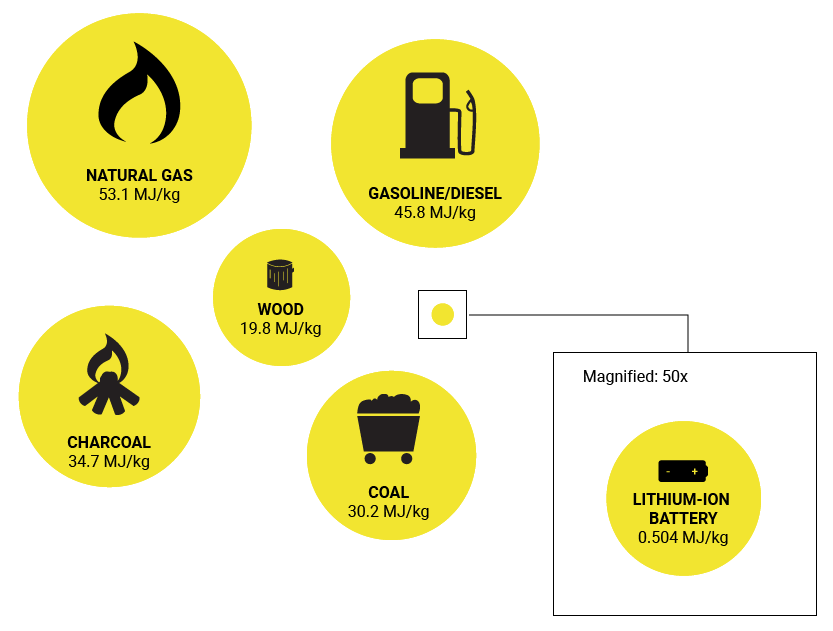
Sources: The Engineering Toolbox; Epec Engineered Technologies
Oil changed the course of history. For example, the British and American navies switched from coal to oil prior to World War I, allowing their ships to go further than coal-fired German ships before refueling. Oil also allowed greater speed at sea and could be moved to boilers by pipe instead of manpower, both clear advantages. During World War II, the United States produced nearly two-thirds of the world’s oil, and its steady supply was crucial to the Allied victory. The German army’s blitzkrieg strategy became impossible when fuel supplies could not keep up, and a lack of fuel took a toll on the Japanese navy.
Natural gas, a fossil fuel that occurs in gaseous form, can be found in underground deposits on its own, but is often present underground with oil. Gas produced with oil was often wasted in the early days of the oil industry, and an old industry saying was that looking for oil and finding gas instead was a quick way to get fired. In more recent times, natural gas has become valued for its clean, even combustion and its usefulness as a feedstock for industrial processes. Nonetheless, because it is in a gaseous form, it requires specific infrastructure to reach customers, and natural gas is still wasted in areas where that infrastructure doesn’t exist.
A final key development in world energy use was the emergence of electricity in the 20th century. Electricity is not an energy source like coal or oil, but a method for delivering and using energy. Electricity is very efficient, flexible, clean, and quiet at the point of use. Like oil, electricity’s first use was in lighting, but the development of the induction motor allowed electricity to be efficiently converted to mechanical energy, powering everything from industrial processes to household appliances and vehicles.
Over the 20th century, the energy system transformed from one in which fossil energy was used directly into one in which an important portion of fossil fuels are used to generate electricity. The proportion used in electricity generation varies by fuel. Because oil — an energy-dense liquid — is so fit-for-purpose in transport, little of it goes to electricity; in contrast, roughly 63% of coal produced worldwide is used to generate electricity. Methods of generating electricity that don’t rely on fossil fuels, like nuclear and hydroelectric generation, are also important parts of the system in many areas. However, fossil fuels are still the backbone of the electricity system, generating 64% of today’s global supply.
Fossil fuels still dominate global electricity generation.
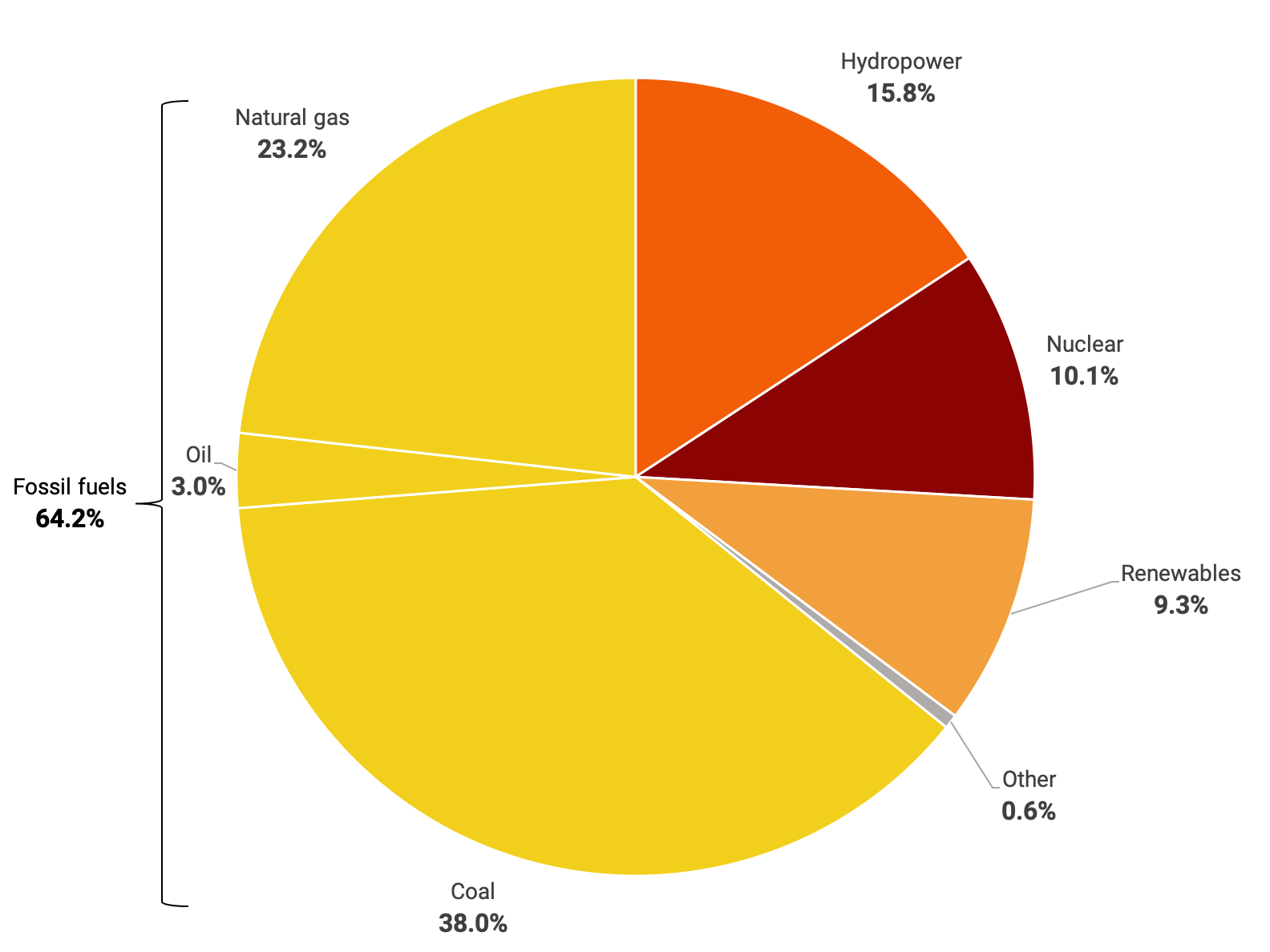
Source: BP Statistical Review of World Energy 2019, 56.
In sum, the story of energy transitions through history has not just been about moving away from current solar flows and toward fossil fuels. It has also been a constant move toward fuels that are more energy-dense and convenient to use than the fuels they replaced. Greater energy density means that a smaller weight or volume of fuel is needed to do the job. Liquid fuels made from oil combine energy density with the ability to flow or be moved by pumps, an advantage that opened up new technologies, especially in transportation. And electricity is a very flexible way of consuming energy, useful for many applications.
Back to the future – the return of the solar era
Fossil fuels allowed us to move away from relying on today’s solar flows, instead using concentrated solar energy stored over millions of years. Before we could make efficient use of solar flows, this seemed like a great idea.
carbon dioxide
Carbon dioxide is gas released when carbon-containing fuels (biomass or fossil fuels) are burned. Carbon dioxide is the most important gas contributing to climate change.
However, the advantages of fossil fuels come with a devastating downside. We now understand that the release of carbon dioxide (CO2) from burning fossil fuels is warming our planet faster than anything we have seen in the geological record. One of the greatest challenges facing humanity today is slowing this warming before it changes our world beyond recognition.
Now that there are almost eight billion of us, we clearly see the impact of rising CO2 concentrations. Going back to the old days of relying mostly on biomass for our energy needs is clearly not a solution. Nonetheless, we need to find a way to get back to reliance on real-time solar flows (and perhaps nuclear energy) to meet our needs. There are so many more of us now, interacting via a vastly larger and more integrated global economy, and using much more energy. But we also have technologies today that are much more efficient than photosynthesis at transforming solar flows to useful energy.
Since 1900, global population and economic activity have skyrocketed, along with fossil fuel consumption.
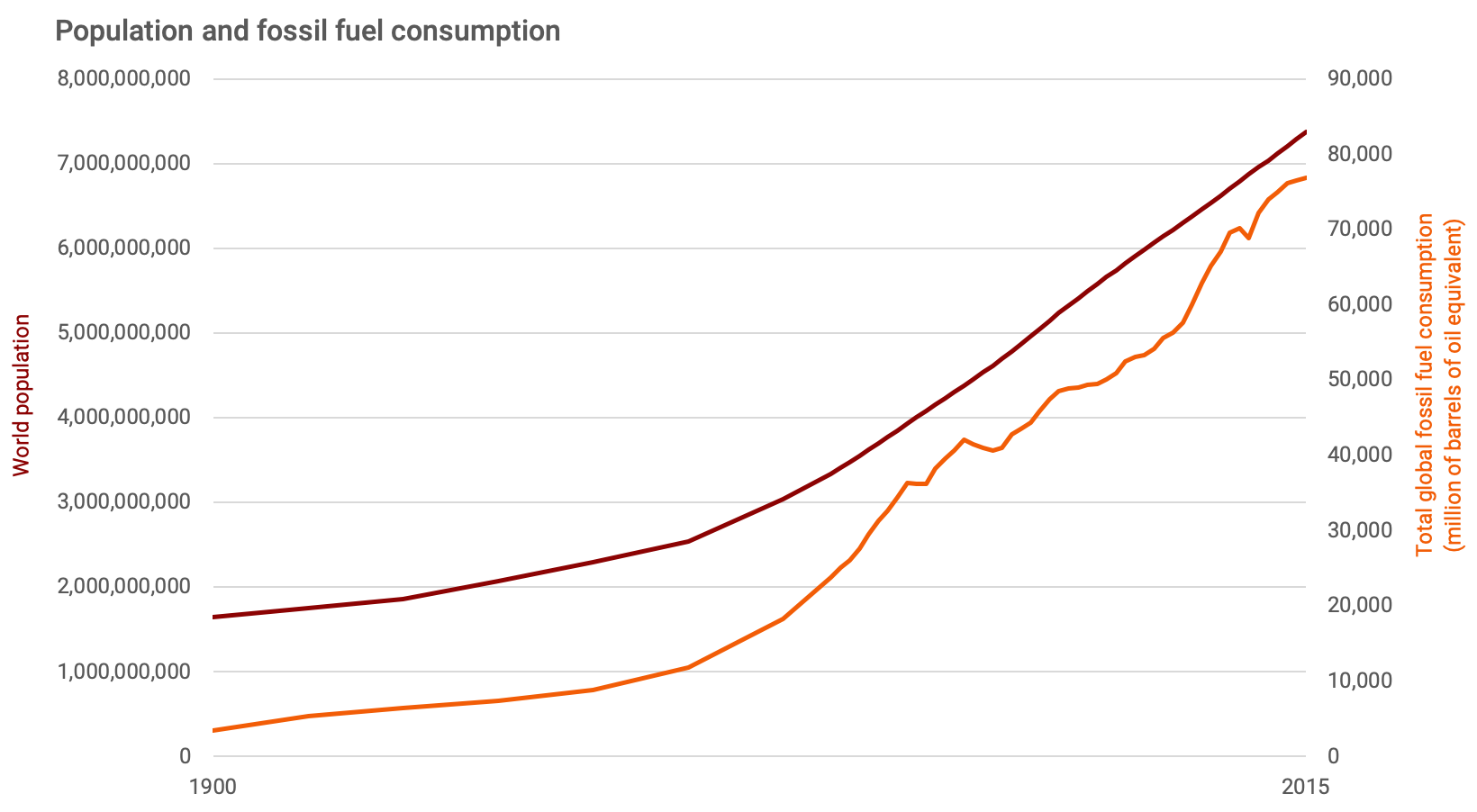
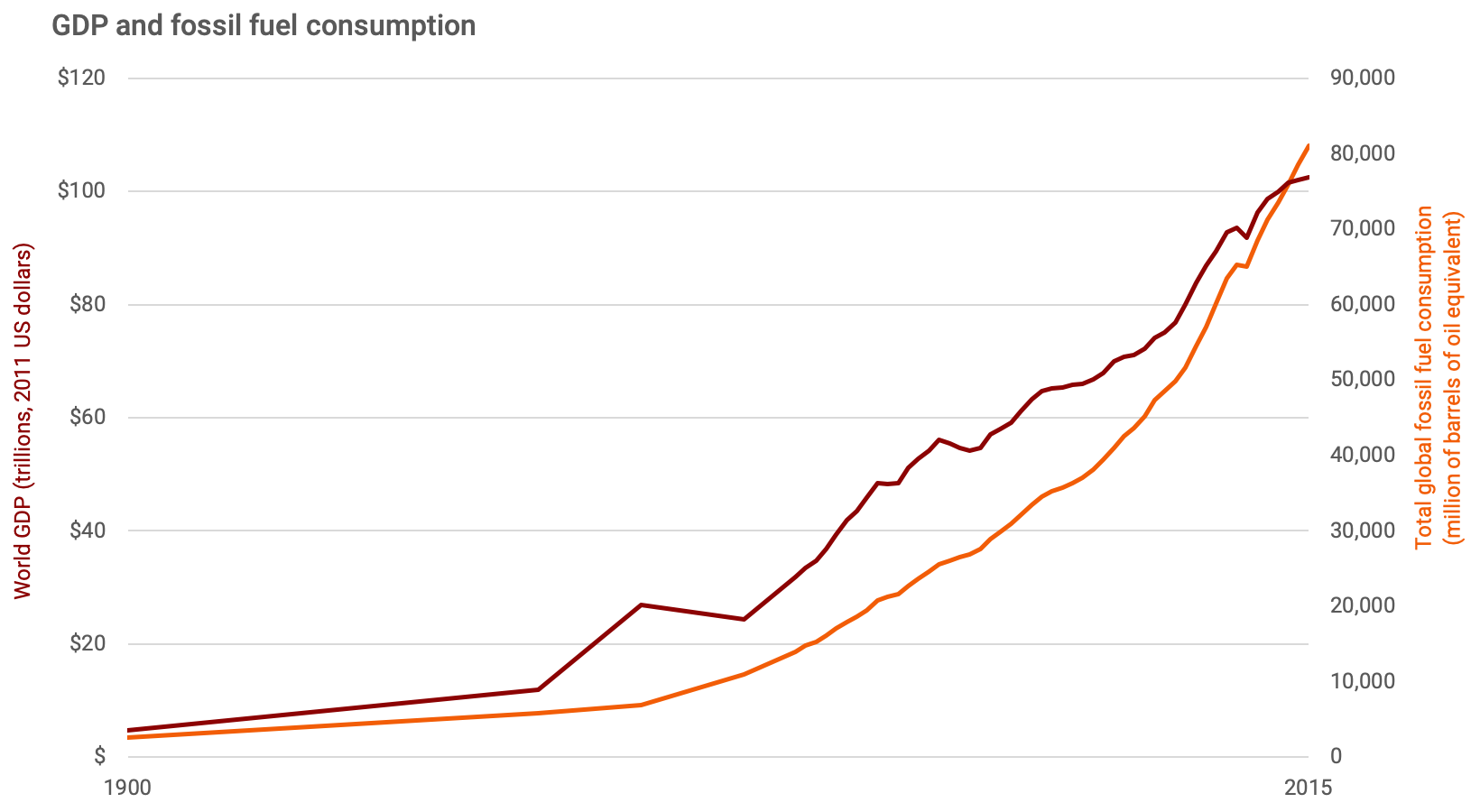
Unfortunately, the atmospheric concentration of carbon dioxide, the most consequential greenhouse gas, has steadily climbed at the same time, along with global average temperature.
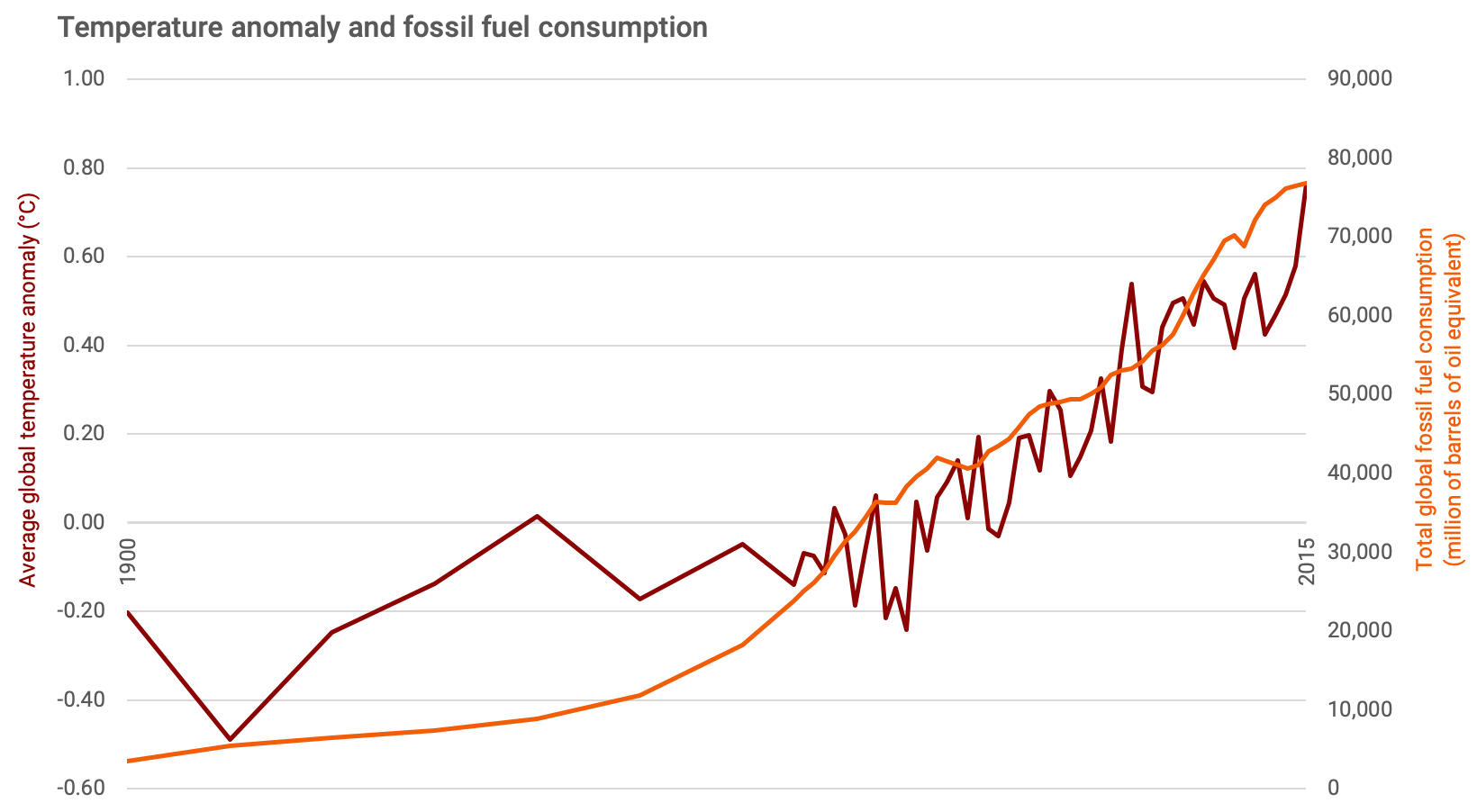
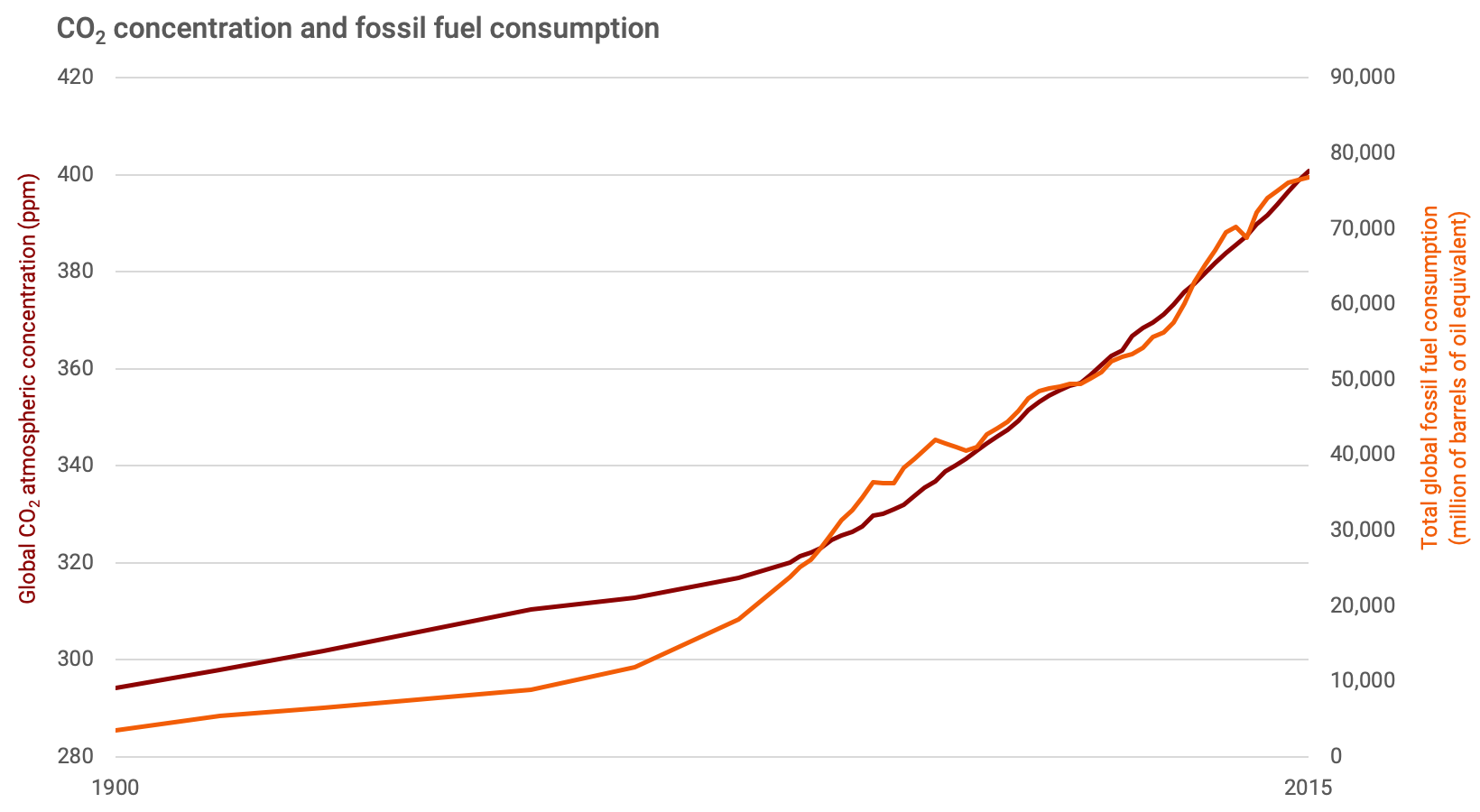
The earth gets plenty of energy from the sun for all of us, even for our modern energy-intensive lives. The amount of solar energy that reaches habitable land is more than 1,000 times the amount of fossil fuel energy extracted globally per year. The problem is that this energy is diffuse. The sun that warms your face is definitely providing energy, but you need to concentrate that energy to heat your home or move a vehicle.
renewable energy
Renewable energy is from a source that is naturally replenished. (Ex: capturing wind using turbines or sunlight using solar cells does not change the amount of wind or sunlight that is available for future use.)
This is where modern technology comes in. Wind turbines and solar photovoltaic (PV) cells convert solar energy flows into electricity, in a process much more efficient than burning biomass, the pre-industrial way of capturing solar energy. Costs for wind and solar PV have been dropping rapidly and they are now mainstream, cost-effective technologies. Some existing forms of generating electricity, mainly nuclear and hydroelectricity, also don’t result in CO2 emissions. Combining new renewables with these existing sources represents an opportunity to decarbonize — or eliminate CO2 emissions from — the electricity sector. Electricity generation is an important source of emissions, responsible for 27% of U.S. greenhouse gas emissions in 2018.
However, unlike fossil fuels, wind and solar can only generate electricity when the wind is blowing or the sun is shining. This is an engineering challenge, since the power grid operates in real time: Power is generated and consumed simultaneously, with generation varying to keep the system in balance.
greenhouse gas
A gas that traps heat in the earth’s atmosphere, including carbon dioxide, methane, ozone, and nitrous oxides.
Engineering challenges beget engineering solutions, and a number of solutions can help. Power grids that cover a larger area are easier to balance, given that if it isn’t windy or sunny in one location, it may be somewhere else. Demand-response strategies can encourage customers with flexibility in their processes to use more power when renewable power is available and to cut back when it isn’t. Power storage technologies can save excess electricity to be used later. Hydroelectric dams can serve this function now, and declining costs will make batteries more economic for power storage on the grid. Storage solutions work well over a timeframe of hours — storing solar power to use in the evening, for example. But longer-term storage poses a greater challenge. Perhaps excess electricity can be used to create hydrogen or other fuels that can be stored and used at a later time. Finally, fossil fuel generation often fills in the gaps in renewable generation today, especially natural gas generation, which can be efficiently ramped up and down to meet demand.
Transforming solar energy flow into electricity is a clear place to start in creating a decarbonized energy system. A simple formula is to decarbonize the electricity sector and electrify all the energy uses we can. Many important processes can be electrified — especially stationary uses, like in buildings and many industrial processes. To deal with climate change, this formula is the low-hanging fruit.
The two parts of this formula must proceed together. A shiny new electric vehicle in the driveway signals your concern about the environment to your neighbors, but achieving its full potential benefit also requires a greener power system. For today’s power system in the United States, and nearly everywhere in the world, electric vehicles provide emissions benefits, but the extent of those benefits varies greatly by location. Achieving the full potential benefit of electric vehicles would require a grid that supplies all renewable or zero-carbon power, something that no area in the United States consistently achieves today.
Wind and solar power aren’t everything – the remaining challenges
“Electrify everything” is a great plan, so far as it goes, but not everything can be easily electrified. Certain qualities of fossil fuels are difficult to replicate, such as their energy density and their ability to provide very high heat. To decarbonize processes that rely on these qualities, you need low-carbon fuels that mimic the qualities of fossil fuels.
The energy density of fossil fuels is particularly important in the transportation sector. A vehicle needs to carry its fuel around as it travels, so the weight and volume of that fuel are key. Electric vehicles are a much-touted solution for replacing oil, but they are not perfect for all uses. Pound for pound, gasoline or diesel fuel contain about 40 times as much energy as a state-of-the-art battery. On the other hand, electric motors are much more efficient than internal combustion engines and electric vehicles are simpler mechanically, with many fewer moving parts. These advantages make up for some of the battery’s weight penalty, but an electric vehicle will still be heavier than a similar vehicle running on fossil fuel. For vehicles that carry light loads and can refuel often, like passenger cars, this penalty isn’t a big deal. But for aviation, maritime shipping, or long-haul trucking, where the vehicle must carry heavy loads for long distances without refueling, the difference in energy density between fossil fuels and batteries is a huge challenge, and electric vehicles just don’t meet the need.
WEIGHT OF FUEL
Gasoline carries much more energy per unit of weight than a battery. A gas-powered car with a 12.4-gallon tank carries 77.5 pounds of gasoline.

A 77.5-pound battery, in contrast, would only carry an electric car 21 miles.

An electric car with a range of 360 miles would need a 1,334 pound battery.

WEIGHT OF VEHICLE
Despite the weight of the battery, other components of electric vehicles are lighter and simpler than their counterparts in a gasoline car. Thus, the overall weight penalty for electric vehicles isn’t as severe as the weight penalty for the battery alone.

Industrial processes that need very high heat — such as the production of steel, cement, and glass — pose another challenge. Steel blast furnaces operate at about 1,100° C, and cement kilns operate at about 1,400° C. These very high temperatures are hard to achieve without burning a fuel and are thus difficult to power with electricity.
Renewable electricity can’t solve the emissions problem for processes that can’t run on electricity. For these processes, the world needs zero-carbon fuels that mimic the properties of fossil fuels — energy-dense fuels that can be burned. A number of options exist, but they each have pros and cons and generally need more work to be commercially and environmentally viable.
Biofuels are a possibility, since the carbon released when the biofuel is burned is the same carbon taken up as the plant grew. However, the processing required to turn plants into usable fuels consumes energy, and this results in CO2 emissions, meaning that biofuels are not zero-carbon unless the entire process runs on renewable or zero-carbon energy. For example, the corn ethanol blended into gasoline in the United States averages only 39% lower CO2 emissions than the gasoline it replaces, given the emissions that occur from transporting the corn to processing facilities and converting it to fuel. Biofuels also compete for arable land with food production and conservation uses, such as for recreation or fish and wildlife, which gets more challenging as biofuel production increases. Fuels made from crop waste or municipal waste can be better, in terms of land use and carbon emissions, but supply of these wastes is limited and the technology needs improvement to be cost-effective.
Another pathway is to convert renewable electricity into a combustible fuel. Hydrogen can be produced by using renewable electricity to split water atoms into their hydrogen and oxygen components. The hydrogen could then be burned as a zero-carbon fuel, similar to the way natural gas is used today. Electricity, CO2, and hydrogen could be also combined to produce liquid fuels to replace diesel and jet fuel. However, when we split water atoms or create liquid fuels from scratch, the laws of thermodynamics are not in our favor. These processes use electricity to, in effect, run the combustion process backwards, and thus use large amounts of energy. Since these processes would use vast amounts of renewable power, they only make sense in applications where electricity cannot be used directly.
Carbon capture and storage or use is a final possibility for stationary applications like heavy industry. Fossil fuels would still be burned and create CO2, but it would be captured instead of released into the atmosphere. Processes under development envision removing CO2 from ambient air. In either case, the CO2 would then be injected deep underground or used in an industrial process.
The most common use for captured CO2 today is in enhanced oil recovery, where pressurized CO2 is injected into an oil reservoir to squeeze out more oil. The idea of capturing CO2 and using it to produce more fossil fuel seems backwards — does that really reduce emissions overall? But studies show that the captured CO2 stays in the oil reservoir permanently when it is injected in this way. And if enough CO2 is injected during oil production, it might make up for the combustion emissions of the produced oil, or even result in overall negative emissions. This won’t be a panacea for all oil use, but could make oil use feasible in those applications, like aviation, where it is very hard to replace.
Carbon capture is today the cheapest way to deal with emissions from heavy industries that require combustion. It has the advantage that it can also capture CO2 emissions that come from the process itself, rather than from fuel combustion, as occurs in cement production when limestone is heated to produce a component of cement with CO2 as a by-product.
When considering how carbon capture might contribute to climate change mitigation, we have to remember that fossil fuels are not the ultimate cause of the problem — CO2 emissions are. If maintaining some fossil fuel use with carbon capture is the easiest way to deal with certain sources of emissions, that’s still solving the fundamental problem.
Our biggest challenges are political
Science clearly tells us that we need to remake our energy system and eliminate CO2 emissions. However, in addition to the engineering challenges, the nature of climate change makes it politically challenging to deal with as well. Minimizing the impact of climate change requires re-making a multi-trillion-dollar industry that lies at the center of the economy and people’s lives. Reducing humanity’s reliance on fossil fuels requires investments here and now that provide uncertain, long-term benefits. These decisions are particularly difficult for politicians, who tend to focus on policies with immediate, local benefits that voters can see. Last year The New York Times asked, for instance, “whether any climate policy is both big enough to matter and popular enough to happen.” Durable climate policy requires securing buy-in from a range of actors, including politicians from both parties, business leaders, and civil society. Their perspectives inevitably differ, and the lack of consensus — combined with very real efforts to exert pressure on the policymaking process — is a key reason that climate action is so politically difficult. (To try your hand at navigating the policy dilemmas, play our — admittedly simplified! — game below: “A president’s climate quandary.”)
In the United States and other parts of the wealthy world, current efforts focus on reducing the greenhouse gas emissions from our energy-intensive lives. But the second part of today’s energy challenge is providing modern energy to the billion people in the developing world that don’t currently have it. You don’t hear as much about the second goal in the public discourse about climate change, but it’s crucial that developing countries follow a cleaner path than the developed world did. The need to provide both cleaner energy and more energy for developing countries magnifies the challenge, but a solution that leaves out the developing world is no solution at all.
Plentiful and inexpensive fossil fuels make transitioning away from them more difficult. Around 15 years ago, pundits were focused on “peak oil” — the idea that the world was running out of oil, or at least inexpensive oil, and that a reckoning was coming. Events of the past decade have proven that theory wrong. Instead of declining oil production and rising prices, we’ve seen the opposite, nowhere more than here in the United States. Technology has brought about a boom in oil production; geologists long knew the resources were there, but did not know how to make money producing them. There’s no reason to expect this trend to slow down anytime soon. In other words, running out of oil will not save us. The world will need to transition away from oil and other fossil fuels while they are abundant and inexpensive — not an easy task.
To achieve this technically and politically challenging transition, we need to avoid one-dimensional solutions. My own thoughts about how we need to deal with climate change have certainly evolved over time, as we understand the climate system better and as time passes with emissions still increasing. As an example, I used to be skeptical of the idea of carbon capture, either from industrial processes or directly from the air. The engineer in me just couldn’t see using such an energy-hungry process to capture emissions. I’ve changed my mind, with a greater understanding of processes that will be hard to decarbonize any other way.
The accumulation of CO2 in the atmosphere is like putting air into a balloon. It’s a cumulative system: We’re continually adding to the total concentration of a substance that may last in the atmosphere for up to 200 years. We don’t know when the effects of warming will become overwhelming, but we do know that the system will become stretched and compromised — experiencing more negative effects — as the balloon fills. The cumulative nature of the climate system means that we need more stringent measures the longer that we wait. In other words: Sooner action is better. We need to take action now where it’s easiest, in the electricity and light vehicle sectors, and in making new buildings extremely energy efficient. Other sectors need more technology, like heavy transport and industry, or will take a long time, like improving our existing stock of buildings.
Those pushing to end fossil fuel production now are missing the point that fossil fuels will still be needed for some time in certain sectors. Eliminating unpopular energy sources or technologies, like nuclear or carbon capture, from the conversation is short-sighted. Renewable electricity generation alone won’t get us there — this is an all-technologies-on-deck problem. I fear that magical thinking and purity tests are taking hold in parts of the left end of the American political spectrum, while parts of the political right are guilty of outright denialism around the climate problem. In the face of such stark polarization, the focus on practical solutions can get lost — and practicality and ingenuity are the renewable resources humanity needs to meet the climate challenge.
Correction: An earlier version of a graphic in this piece mistakenly indicated that renewables comprise 0.6% of global electricity generation. It has been corrected to 9.3%.
Acknowledgments
Editorial: Jeff Ball, Bruce Jones, Anna Newbyu
Research: Historical summaries of energy transitions owe a debt of gratitude to Vaclav Smil, a prolific author on the topic and the grandfather of big-picture thinking on energy transitions.
Graphics and design: Ian McAllister, Rachel Slattery
Web development: Eric Abalahin, Abigail Kaunda, Rachel Slattery
Feature image: Egorov Artem/Shutterstock





